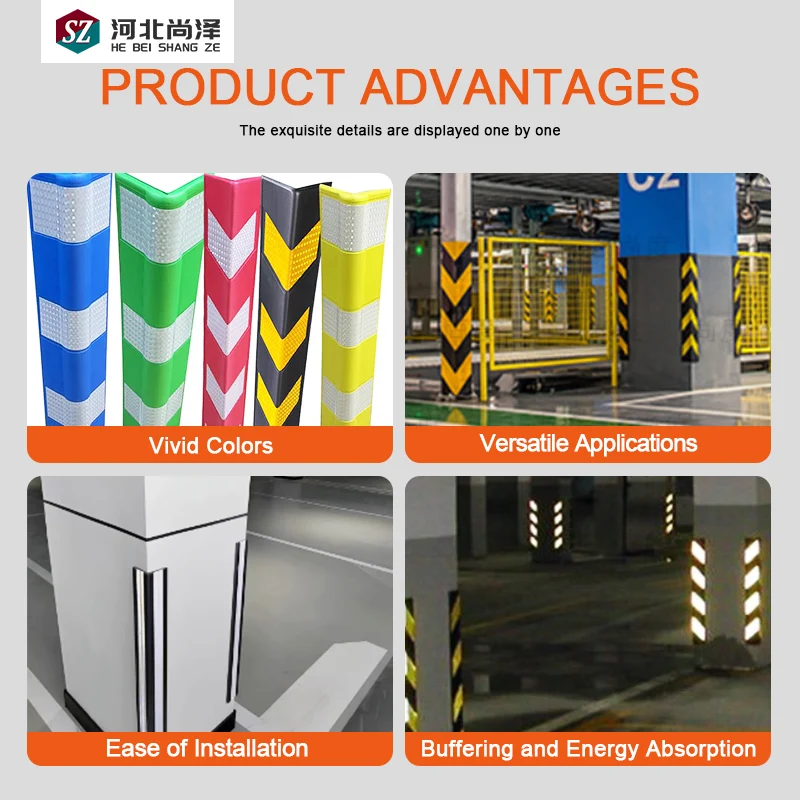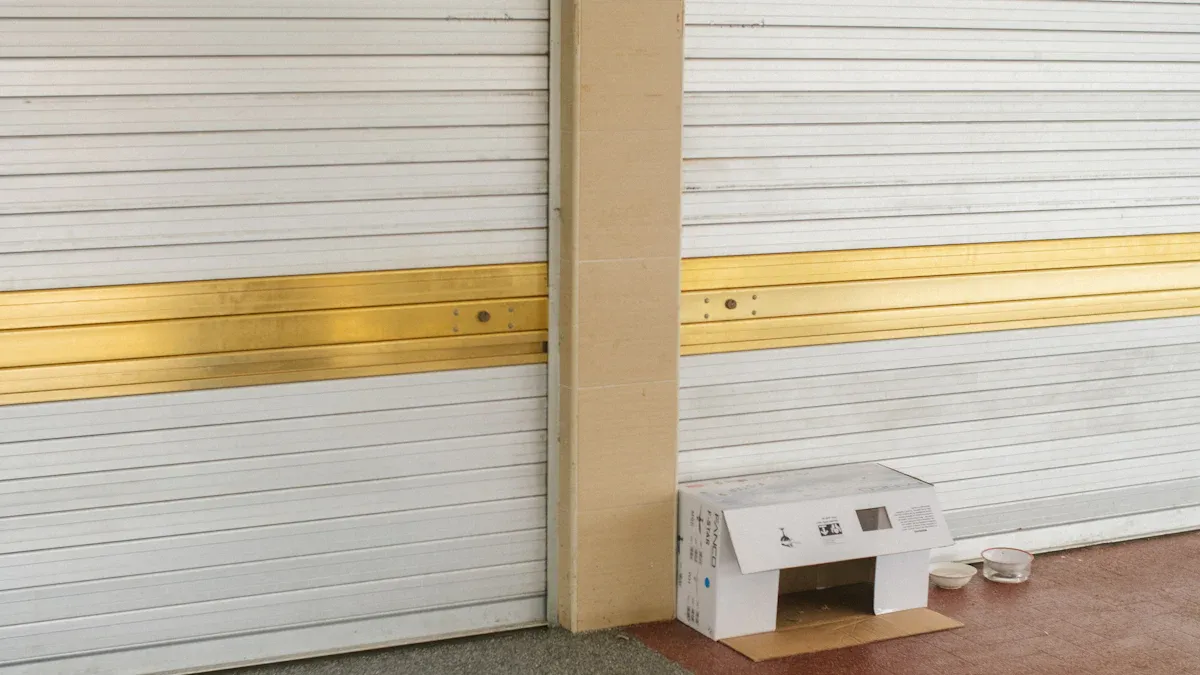
If you want to keep your walls safe, rubber wall protectors are a great choice. They last a long time and are easy to clean. They help stop damage from bumps in busy places like garages 🚗, hospitals, and warehouses. Think about what you need:
- Busy areas need strong corner protectors for the best coverage.
- Fire and water resistance are important. Some panels and guards have ratings that meet 2024 OSHA, ADA, and ASTM rules.
Choose wall protectors that fit your space’s traffic, style, and safety needs.
Key Takeaways
- Pick the right wall protector for your space. Garages need strong corner guards. Hospitals need materials that are easy to clean. Warehouses need protectors that last a long time.
- Make sure wall protectors follow safety rules like 2024 OSHA, ADA, and ASTM. This helps keep people safe and follows the law in busy places.
- How you install wall protectors is important. Clean the wall first. Use the right glue. Check that the protector fits tightly. This helps it work well and last longer.
- Take care of wall protectors often. Clean them so they stay nice. Replace them if they break. This keeps your space safe and looking good.
- Think about how much money you want to spend. Look at prices and materials. Pick wall protectors that work for you and do not cost too much.
Choosing Wall Protectors
Key Factors
When you pick wall protectors, you want your walls to stay safe. You should think about how many people use the space. Busy places need strong protection, especially at corners. Check if the product follows 2024 OSHA, ADA, and ASTM safety rules.
Here are some things to look for:
| Type of Wall Protection | Description |
|---|---|
| Chair Rails | Stops chairs from hurting walls. |
| Hand Rails | Helps people and protects busy areas. |
| Corner Guards | Keeps corners safe from bumps. |
| Wall Guards | Stops marks and scratches on walls. |
| Rigid Wall Sheets | Gives strong cover for busy spots. |
| Wall Bases | Protects the bottom part of walls. |
You should check what glue is used.
- Make sure the glue does not have bad VOCs.
- Stay away from Red List chemicals.
- Pick low-emission products that follow CDPH CA Specification 01350.
- Choose wall protectors that pass Class A fire tests.
Tip: Always pick the best way to install for your space. Check the glue and make sure your wall protectors pass fire safety rules.
Matching to Environment
Wall protectors should fit your space. Every place needs something different. Here is a simple guide:
- 🚗 Garage: Garages need strong corner guards for busy areas. Commercial garages use tough guards with aluminum holders. Homes can use tape, screws, or glue.
- 🏥 Hospital: Hospitals need special protection. Pick strong materials that are easy to clean. Walls and corners need extra care in patient rooms and halls. Cleanliness and easy care are most important in busy spots.
- 🛠️ Warehouse: Warehouses need wall protectors that can take hits and heavy use. They should be strong, keep out moisture, and be safe from fire. Think about price and looks if people see your warehouse.
Wall protectors should work well and look nice. Pick colors and materials that match your style.
- Corner guards and kick plates keep walls safe and look good.
- Handrails come in many styles for nice designs.
- Floor rail systems can make spaces look modern.
“Think about your project and what you need before using filters or talking to a product expert: Do you want certain materials or colors, like wood handrails or stainless steel handrails?”
If you run a commercial garage, use strong corner guards for busy spots. Homes can use softer options. Hospitals need tough, easy-to-clean wall protectors for health. Warehouses need walls that are strong and safe from water and fire.
Types of Wall Protectors
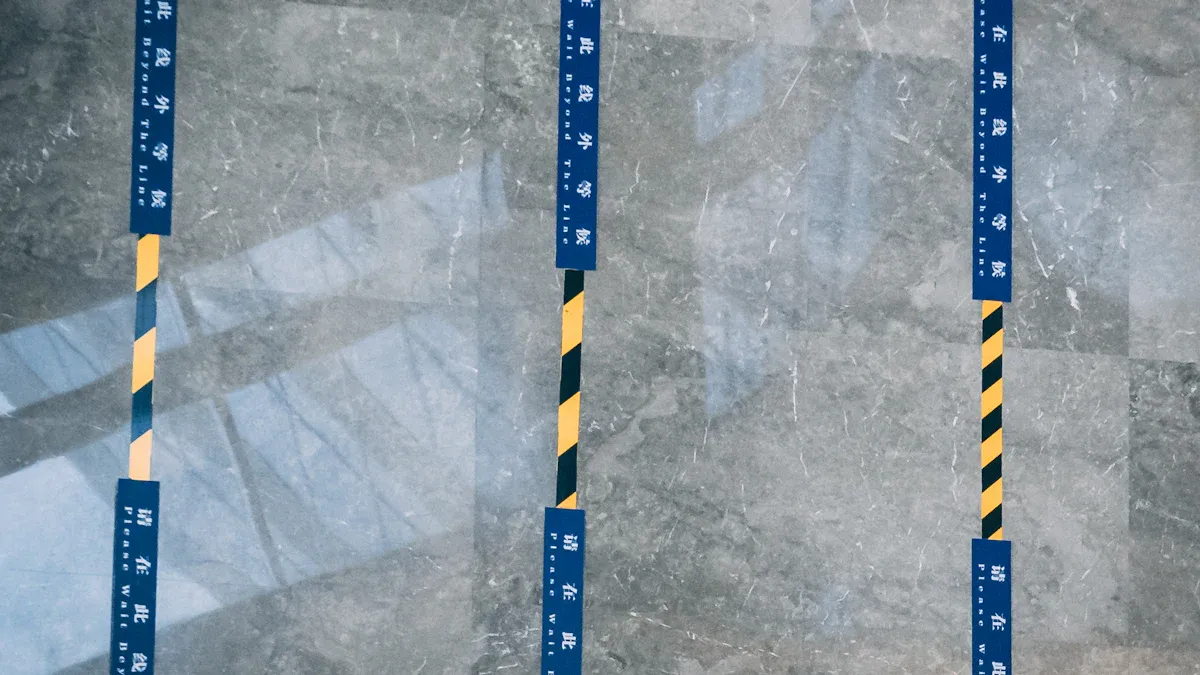
Garage
🚗 Garages get lots of bumps and scrapes. You need wall protectors that can take hard hits. Wall corner guards keep corners safe when cars or bikes hit them. You can pick commercial corner guards for busy garages. For homes, you can use residential corner guards. Commercial guards use strong materials and follow 2024 OSHA, ADA, and ASTM rules. Home guards are softer and stick on easily with glue or tape.
- Commercial corner guards last a long time and stop hard hits.
- Bumper guards go along the wall to block doors or carts.
- Decorative rails make walls look nice and protect them.
Tip: Put wall protection panels or rubber wall strips in busy spots for extra safety.
Hospital
🏥 Hospitals need tough wall protectors for safety and to stay clean. Wall corner guards protect corners from carts and beds. Crash rails, also called bumper guards, keep walls safe from bumps. Handrails help people walk safely and protect walls too.
Fireproof panels give extra safety. Hospitals use them because:
- They resist fire very well
- They help labs and kitchens follow fire rules
- They last a long time in busy places
- They are easy to clean and take care of
Pick wall protectors that follow strict 2024 OSHA, ADA, and ASTM rules. Hospital wall protectors should be easy to clean and not stain.
Warehouse
🛠️ Warehouses need wall protectors that can handle heavy use. Wall corner guards and bumper guards keep corners and walls safe from forklifts and pallets. Water-resistant boards like Sintra Board work best in wet or tough places.
| Material | Durability | Moisture Resistance | Best Use |
|---|---|---|---|
| Sintra Board | Very strong, weatherproof | Great at stopping water | Good for indoor and outdoor use |
| Gator Board | Strong, not as weatherproof | Handles some water | Good for signs inside |
| Foam Board | Light, dents easily | Not good with water | Good for short-term displays |
Cement boards also stop damage and stay strong in wet places. You need strong protection for corners and walls in loading docks and busy aisles.
Note: Choose wall protectors that fit your warehouse and follow 2024 safety rules.
Installation Options
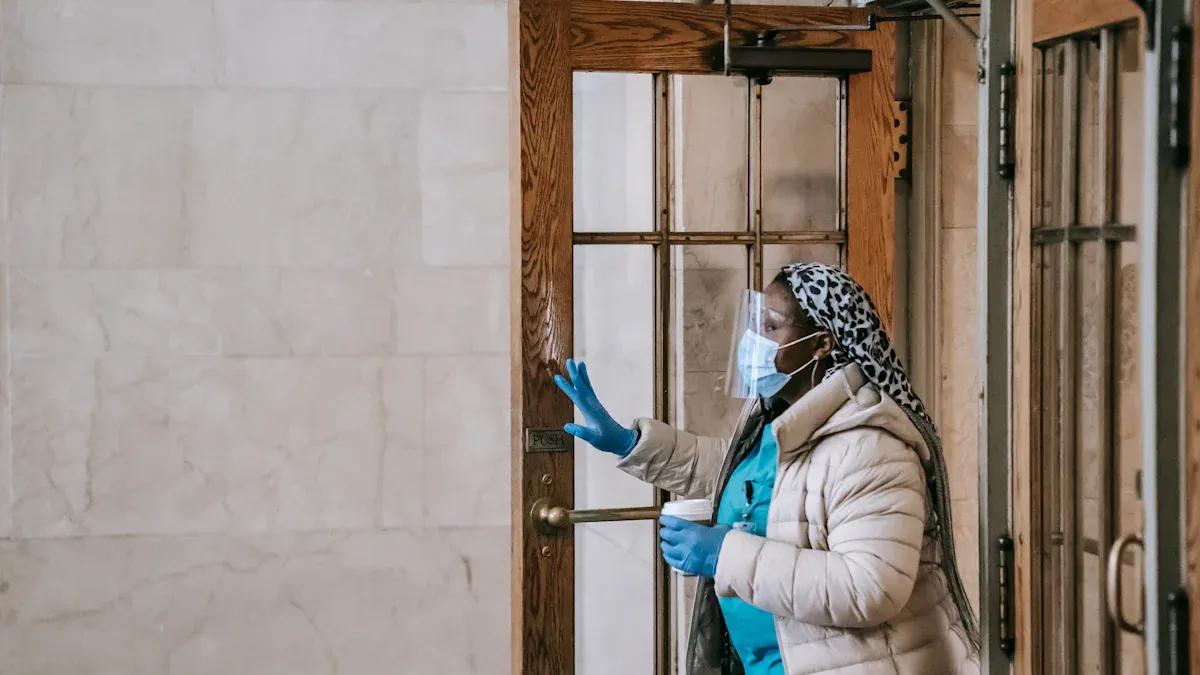
When you install wall protectors, you want the best fit for your space. Each setting—garage, hospital, or warehouse—has its own steps and tips. Let’s look at the best installation options for each.
Garage Steps
🚗 Garages see a lot of bumps and scrapes. You need to protect every corner and wall from impact. Here’s how you can install wall protectors in your garage:
- Find Contact Points
Look for spots where cars, bikes, or tools hit the walls or corners most often. - Pick the Right Protection
- Use protective bumpers made from dense foam, plastic, or rubber at these spots.
- Wall padding works well in tight spaces.
- Durable wall coverings like PVC panels resist moisture and impact.
- Column guards protect every corner and post.
- Protective wall panels made from PVC, fiberglass, or metal give strong defense and make cleaning easy.
- Prepare the Surface
Clean the area. Make sure it’s dry and free from dust or oil. - Attach the Protectors
- Use adhesives, screws, or mounting tape, depending on the product.
- Press firmly so the protector sticks well.
- For corners, wrap the guard tightly and check for gaps.
- Check for Secure Fit
Push on the protector to make sure it won’t move. Add extra screws or glue if needed.
Tip: Use pre-cut panels or strips to save time and money. Always follow the latest 2024 OSHA, ADA, and ASTM standards for safety.
Hospital Steps
🏥 Hospitals need fast and clean installation. You want to keep downtime low and meet strict safety rules. Here’s what you should do:
- Plan the Layout
Mark high-traffic areas, corners, and walls that need protection. - Choose Modular Systems
Modular wall protectors like SwiftWall let you install and remove panels quickly. This helps you finish the job fast and keeps patient areas open. - Prepare the Area
Clean and disinfect the surface. Make sure the wall is dry. - Install the Panels
- Snap or slide modular panels into place.
- For corners, use special corner guards that fit snugly.
- Use adhesives or screws as needed, but modular systems often need fewer tools.
- Check for Gaps and Secure Fit
Make sure each panel and corner guard sits tight. Fill any gaps to stop germs and dirt.
Note: Modular systems cut labor and material costs. They also help you meet 2024 OSHA, ADA, and ASTM standards with less downtime.
Warehouse Steps
🛠️ Warehouses need tough protection for every corner and wall. You want to save money and keep the job simple. Here’s how you can do it:
- Spot High-Risk Areas
Look for corners, loading docks, and aisles where forklifts or pallets hit the walls. - Pick Easy-to-Install Panels
PVC wall panels work best. They come pre-cut, so you spend less time and money on labor. - Prepare the Surface
Clean and dry the wall. Remove any old glue or dirt. - Install the Panels and Guards
- Place the panels against the wall.
- Use screws or adhesives as needed, but many PVC panels snap into place.
- For corners, use corner guards made from rubber or plastic.
- Seal and Check
Make sure the panels fit tight. The design stops moisture from getting in, which helps prevent damage.
Tip: PVC panels are water-resistant and have antimold coatings. You don’t need extra glue or lamination, so you save on costs and repairs.
By following these steps, you can keep your walls safe from impact and damage. Each setting has its own best options, but the goal stays the same: strong, lasting protection for every corner and wall.
Cost Comparison
By Type
There are many wall protectors you can buy. Prices are different for each type. Rubber wall protectors fit many budgets. Here is a table that shows price ranges for popular products:
| Product Description | Price Range | Minimum Order |
|---|---|---|
| Rubber Column Guard Wall Angle 90 Degree Corner Rubber Guard | $2.78-4.65 | 200 meters |
| height800mm 2.5kgs rubber corner guards for walls | $1.40-1.50 | 500 pieces |
| Industrial Rubber Corner Guards /glass Corner protection | $0.10-1 | 100 pieces |
| Essential Safety Equipment Rubber Wall Protector Corner Guards | $2-2.88 | 20 pieces |
| 1200mm Wall Edge Corner Guard Protector | $2.40-2.50 | 500 pieces |
| One Yellow Strip Good Quality Rubber Material Wall Corner Guard | $6.49-8.49 | 5 pieces |
| Premium Durable Rubber Corner Guard | $2.50 | 100 meters |
| L-Shaped Rubber Safety Corner Guard | $1.20-1.40 | 100 pieces |
| Wholesale Forklift Warehouse Car Parking Space Lot Garages Column Square Angle | $1.75-1.95 | 1000 pieces |
| Reflective Corner Guard Rubber Column Guard | $1-100 | 200 pieces |
| Rubber and Steel Reflective Corner Edge Guard Protector | $5 | 500 pieces |
| OEM Factory Rubber Hospital Corner Guard | $0.69-1.89 | 500 pieces |
| Corner Guard 8001008mm Rubber Corner Guard | $1 | 1000 pieces |
| Industrial Design Rubber Corner Guard Wall Protectors | $1.60-2 | 200 pieces |
| 60-150cm Rubber Corner Edge Wall Protector | $1.10-1.30 | N/A |
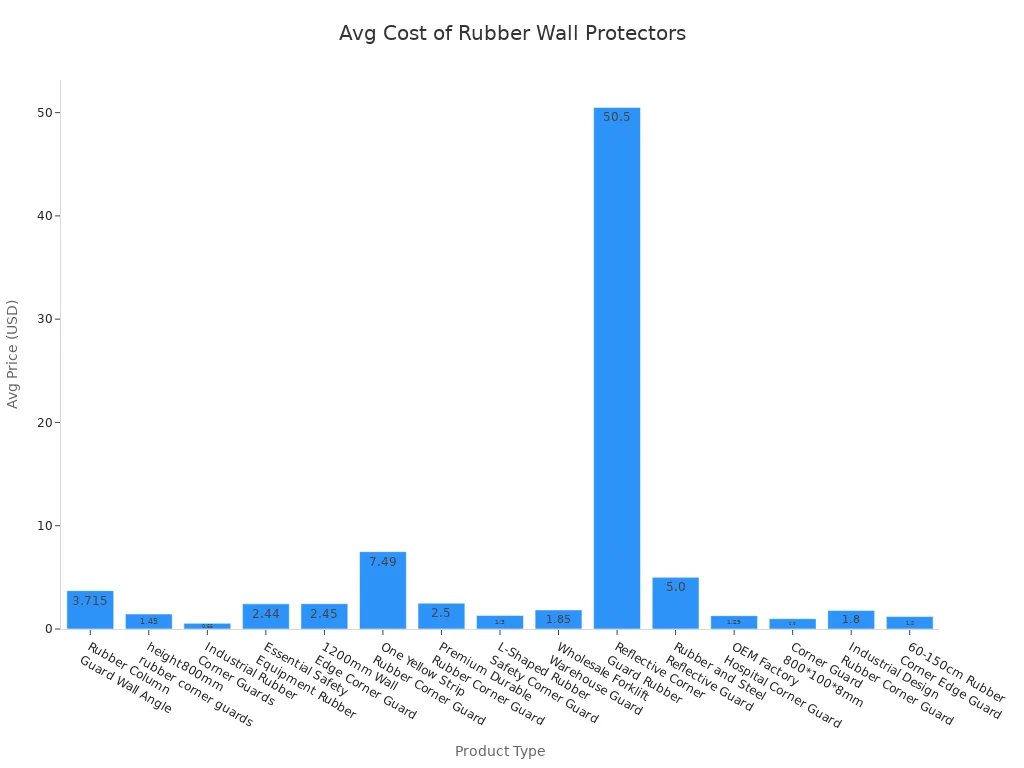
The material you pick changes the price. PVC bends easily and costs less. Rubber is tougher and absorbs hits better. Stainless steel is the most expensive but lasts longest.
| Material | Properties | Price Impact |
|---|---|---|
| PVC | Flexible, cost-effective | Lower price due to affordability |
| Rubber | Resilient, impact-absorbing | Moderate price due to durability |
| Stainless Steel | Strong, long-lasting | Higher price due to strength |
By Setting
Prices are different for garages 🚗, hospitals 🏥, and warehouses 🛠️. Each place needs special wall protectors. Here is a table that shows starting prices:
| Product Name | Starting Price |
|---|---|
| Grab Bars | Stainless Steel Floor To Wall-A1080 |
| McCue CartStop Box Rail-A1330 | $168.48 |
| McCue CartStop RE-A1331 | $360.56 |
| McCue CartStop Stainless Steel Rail-A1332 | $304.44 |
| Boston Retail EcoRigid® 3050 Wall Protection Bumpers-A164 | $61.33 |
| Boston Retail EcoFlex® 3300 Wall Guard Bumpers-A165 | $324.00 |
| CS Acrovyn® Rigid Sheet and Trim-A263 | $16.35 |
| McCue Wall Guard Bumpers Rigid GreenGuard 1, 2 | Flexible CartGuard 1, 2-A6903 |
| McCue FlexCore Stainless Steel Post-A1335 | $428.06 |
| Stainless Steel 22 GA End Wall Guards | $15.63 |
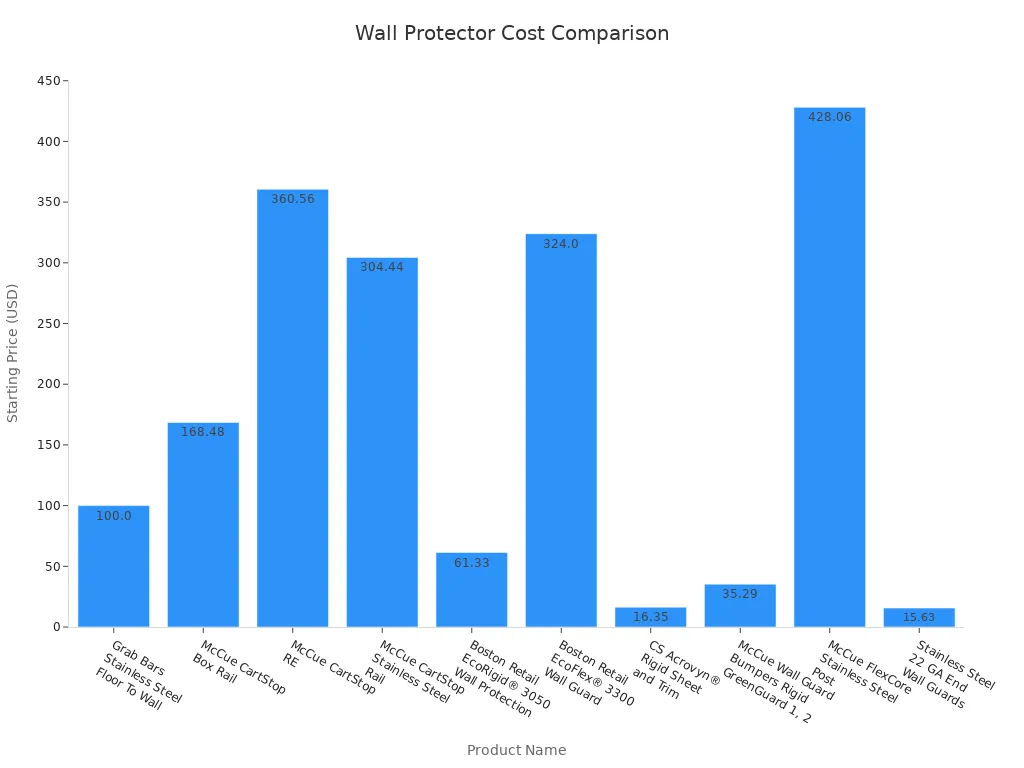
Heavy-duty wall protectors for hospitals and warehouses cost more. Homes can use cheaper corner guards. Always check if your product meets 2024 OSHA, ADA, and ASTM rules.
Budget Tips
Want to spend less money? Try these ideas:
- Pick wall coverings that are eco-friendly and resist damage.
- Use temporary wall systems that you can reuse for renovations.
- Clear corner guards work well for big projects. Custom sizes cost extra.
- Choose wall panels that look nice and are easy to install and clean.
- Use glue for fast installs and less work.
Tip: Match your wall protectors to your space. Busy places need strong corner guards. This helps stop damage and saves money on repairs.
Maintenance
Cleaning
Keeping your wall protectors clean is simple. You do not need special tools or cleaners. Most rubber wall protectors, especially those with dark colors and yellow stripes, hide dirt and marks well. You can just wipe them down with a wet cloth. If you see more dirt, use a hose for a quick rinse. This routine works great in garages 🚗, hospitals 🏥, and warehouses 🛠️. You save money because you do not need to repaint or scrub hard.
Here are some easy cleaning tips:
- Wipe corners and edges every week.
- Use mild soap if you see sticky spots.
- Dry the area after cleaning to stop slips.
- Check for loose adhesives while you clean.
Tip: Regular cleaning keeps your protection strong and helps you spot any early signs of damage.
Replacement
Sometimes, you need to replace a wall protector. Look for cracks, deep scratches, or if a corner guard comes loose. High-traffic areas may need new protectors sooner. If you see a wall bumper or corner wall protector that does not fit tight, it is time for a change.
Follow these steps for easy replacement:
- Remove the old protector. Pull gently to avoid wall damage.
- Clean the spot. Make sure no old adhesives or dirt remain.
- Place the new protector. Press it firmly into the corner or along the wall.
- Check that it meets 2024 OSHA, ADA, and ASTM standards.
Note: Quick replacement keeps your space safe and looking good. Always use the right size and type for your area.
You want the best protection for your space, so start by checking these key points:
- Pick the right size for each corner and area.
- Choose lock types that fit your needs.
- Look for fire and water resistance.
- Use strong materials to stop damage.
- Compare prices and trusted brands.
When you install, always check adhesives and make sure each corner guard fits tight. If you need help, talk to suppliers or installers:
- Ask about quality installation.
- Check if products meet 2024 safety standards.
- Make sure panels are certified.
FAQ
What makes rubber wall protectors safe for children?
Rubber wall protectors cover every corner and edge. You keep children safe from sharp corners and hard surfaces. Many products meet 2024 OSHA, ADA, and ASTM standards for safety for children. You can use them in playrooms, schools, and hospitals 🏥.
Can I install corner guards without professional help?
Yes, you can install corner guards yourself. You just clean the area, apply adhesives, and press the guard onto the corner. Most kits include easy instructions. You save money and protect your walls from damage.
How do I choose the best protection for a garage 🚗?
You look for rubber wall strips, wall bumper panels, and corner wall protectors. Pick products that resist impact and moisture. Always check if they meet 2024 OSHA, ADA, and ASTM standards. You want strong protection for busy garages.
Are rubber wall protectors good for children’s rooms?
Yes, you can use rubber wall protectors in children’s rooms. They cover every corner and stop injuries. You get extra safety for children and prevent damage from toys or furniture. Cleaning is easy, and you keep the space safe.
What signs show I need to replace a corner wall protector?
You notice cracks, loose adhesives, or deep scratches on the corner. If the protector moves or does not fit tight, you should replace it. Quick replacement keeps your protection strong and stops further damage.

